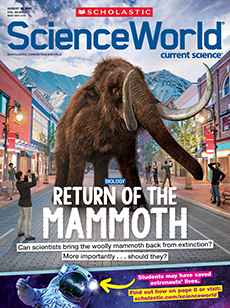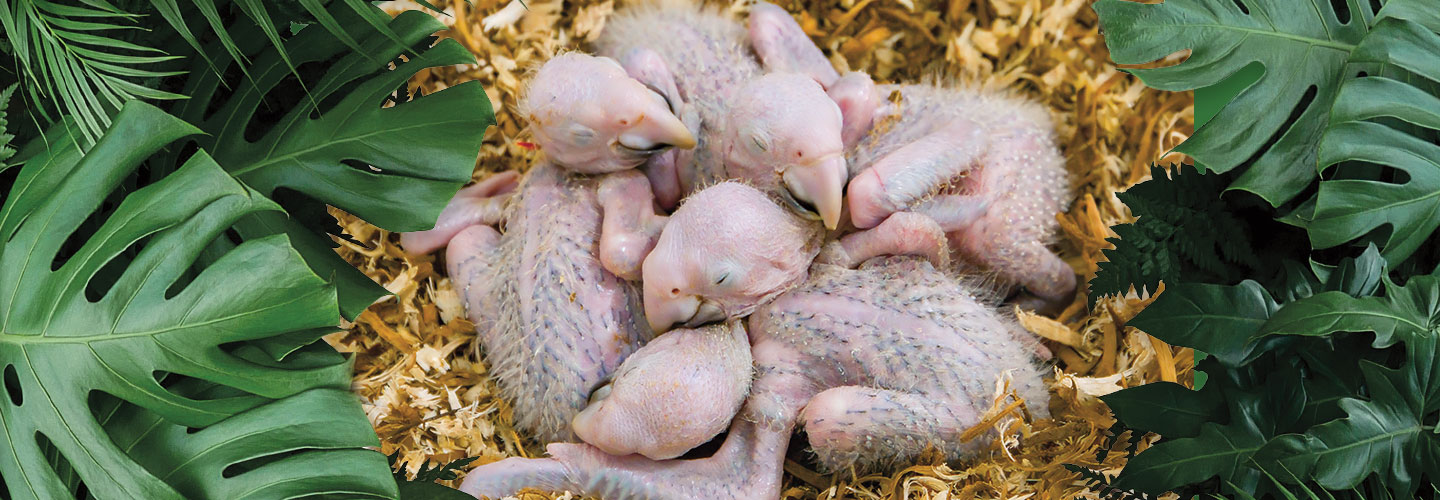BEEP! BEEP! BEEP! Biologist Diego Noriega awakens to the sound of his alarm clock. It’s 3 a.m., and the chicks will be hungry. Noriega climbs out of bed and slips on his shoes. Then he grabs a flashlight and umbrella and goes outside. The forest is full of sound, from the pitter-patter of raindrops to the chirps, peeps, and squawks from crickets, frogs, and birds. Noriega shines his light across the forest floor, watching out for venomous snakes or stinging scorpions as he walks.
Soon Noriega arrives at the bird nursery. RAAAK! He’s greeted by the screams of four tiny scarlet macaws. Still in his pajamas, Noriega mashes puppy kibble, cereal meant for human babies, peanut butter, and pureed mango with warm water. He spoons the formula into the week-old chicks’ mouths, and they gulp it down. Then he tucks them back into their incubator—a machine that keeps the featherless babies warm. Noriega goes back to bed. In three hours, he’ll have to feed the chicks again.
These around-the-clock feedings are part of a plan to save Mexico’s remaining scarlet macaws. The rainbow-colored birds are found in forests across Latin America, but the subspecies Ara macao cyanoptera, which lives in Central America, is endangered. Only about 1,000 of the birds still exist in the wild. Most are found in the Lacandon Rainforest at the southern tip of Mexico, where Noriega works at the Chajul Biological Station (see “Bird Range”).
The biggest threat facing Mexico’s macaws is poachers who illegally capture chicks from the wild. Twenty years ago, Noriega and others at the conservation group Natura y Ecosistemas Mexicanos (which translates to Mexican Nature and Ecosystems) hatched a radical plan to help the birds. They would take chicks from their nests before poachers arrive. Then they’d raise the baby birds until they were big enough to survive on their own in the wild.
BEEP! BEEP! BEEP! The alarm clock wakes up biologist Diego Noriega. It’s 3 a.m., and the chicks will be hungry. Noriega climbs out of bed and slips on his shoes. Then he grabs a flashlight and umbrella and goes outside. The forest is full of sound. Raindrops pitter-patter. Crickets, frogs, and birds chirp, peep, and squawk. Noriega shines his light across the forest floor. He watches for venomous snakes or stinging scorpions as he walks.
Soon Noriega arrives at the bird nursery. RAAAK! Four tiny scarlet macaws are screaming. Noriega is still in his pajamas. He takes puppy kibble, cereal for human babies, peanut butter, and pureed mango. He mashes this food with warm water. Then he spoons the formula into the week-old chicks’ mouths. They gulp it down. He tucks them back into their incubator. This machine keeps the featherless babies warm. Noriega goes back to bed. In three hours, he’ll have to feed the chicks again.
The chicks are fed around the clock. It’s part of a plan to save Mexico’s last scarlet macaws. The rainbow-colored birds live in forests across Latin America. But the subspecies Ara macao cyanoptera lives in Central America, and it’s endangered. Only about 1,000 of the birds still exist in the wild. Most are found in the Lacandon Rainforest at the southern tip of Mexico. Noriega works there at the Chajul Biological Station (see “Bird Range”).
The biggest threat to Mexico’s macaws is poachers. They illegally catch chicks from the wild. Noriega works with others at the conservation group Natura y Ecosistemas Mexicanos. (This translates to Mexican Nature and Ecosystems.) Twenty years ago, they hatched a radical plan to help the birds. They would take chicks from their nests before poachers arrive. Then they’d raise the baby birds until they could survive on their own in the wild.

